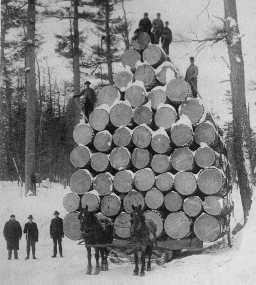
Mike C,
I believe there were some major fires that helped wipe out the Michigan forests, as well as the 19th century lumber barons in the upper regions of the lower peninsula of Michigan,.. there are some very famous real big trees that survived them at Hartwick Pines State Park that you may have seen signs for off I-75 between Grayling and Gaylord, and there are many such stands of later growth replanted trees and more recently the odd christmas tree farms that were never harvested up there..
"Logging companies often did not confine their cutting to the area they had purchased. There was the practice of "logging a round forty," which meant buying forty acres and then cutting the timber around it in all directions far beyond the boundaries of the area to which title had been secured. By 1900 most of the pine in the Lower Peninsula was gone. Pine logging in the Upper Peninsula began to assume greater importance in the 1880s, and the virgin stands lasted until about 1920. The peak of Michiganís great timber harvest was reached in 1889-1890 when mills cut a total of 5.5 billion board feet of lumber, mostly pine.
By the boomís end, logging had stripped 19.5 million acres, none of which was replanted, leaving vast tracts of barren wasteland. The lumber barons attempted to unload the now worthless land by setting up demonstration farms, using large amounts of fertilizer to convince unsuspecting buyers that the soil was suitable for farming. Many small plots were sold to people who put up their life savings, only to find out after a couple of unproductive growing seasons that they had been cheated. Most of the barren land couldnít be sold under any circumstances and it reverted to state ownership as the lumber barons abandoned it because they didnít want to continue paying taxes on it.
During the depression of the 1930s, one of the projects assigned to the Civilian Conservation Corps (CCC), made up of out-of-work young men, was to repair the damage done to the nationís forests by clear-cutting. The CCC planted millions of seedlings and over time most of Michiganís barren areas were reforested. However, some areas known as "stump prairies" still exist, even though it has been over a century since they were stripped of trees.
Today, over half of Michiganís land mass is covered by forests. Logging, which never disappeared altogether, continues, especially in the stateís northern counties, but it is being done very selectively, to preserve and protect the remaining old-growth forests. Tree farming began in 1941, and now accounts for the overwhelming majority of the nearly 675 million board-feet of lumber that Michigan produces annually. Michigan also produces over 15 million Christmas trees each year, representing approximately 15% of the nationís supply."
is that Joe Hancock up on that pile of sticks, after some winter pruning?
